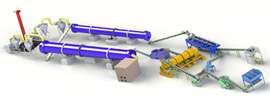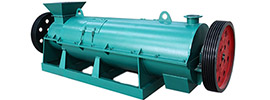Stable FertilizerFertilizer made by mixing
livestock manure and urine with washer materials and feed stubble and by the action of microorganisms. It is rich in organic matter and various nutrients. Among all kinds of livestock manure and urine, the nitrogen, phosphorus and potassium content of sheep manure is high, followed by pig and horse manure, and cow manure is the lowest; the excretion volume is the most for cow manure, followed by pig and horse, and the least for sheep manure. The washer materials are straw, weeds, fallen leaves, peat and dry soil, etc. Stable fertilizer is divided into circle accumulation system (the washer material directly into the barn to absorb manure and urine) and outside the circle accumulation system (the livestock manure and urine clear out of the barn and washer material stacked layer by layer). It is decomposed and matured by smack gas. During the accumulation period, its chemical components are changed by the action of microorganisms. The role of stable manure: ① Provide plant nutrients. Including essential large elements of nitrogen, phosphorus, potassium, calcium, magnesium, sulfur and trace elements of iron, manganese, boron, zinc, molybdenum, copper and other inorganic nutrients; amino acids, amides, nucleic acids and other organic nutrients and active substances such as vitamin B1, B6, etc. Maintain the relative balance of nutrients. ②Improve the effectiveness of soil nutrients. Stable fertilizer contains a large number of microorganisms and various enzymes (protease, urease, phosphorylase), which induce the organic state of nitrogen and phosphorus to become inorganic state for crop absorption. It also enables the formation of stable complexes of calcium, magnesium, iron and aluminum in the soil to reduce the fixation of phosphorus and increase the effective phosphorus content. ③Improve soil structure. Humus colloid promotes the formation of soil agglomerate structure, reduces bulk weight, improves soil permeability, and coordinates water and air conflicts. It can also improve the buffering of soil and improve mineral toxic fields. ④ Fertilize the ground and improve the fertility and water retention of the soil. Stable fertilizer is mainly used as base fertilizer after rotting. The nutrients of fresh stable fertilizer are mostly in organic state, and the carbon to nitrogen ratio (C/N) value is large, so it should not be applied directly, especially not directly into the rice field.
Composted FertilizerIt is a fertilizer made by
fermenting crop stalks, green manure, weeds and other plant materials with river and pond mud and human excrement and urine in a waterlogged pit through anaerobic respiration of microorganisms. It is generally applied to rice fields as base fertilizer. Composted fertilizer can be divided into two categories: composted fertilizer and grass pond mud. Cesspool fertilizer can be accumulated at any time, grass pond mud is accumulated in the winter and spring season. Accumulation system due to lack of oxygen, so that divalent iron, manganese and a variety of organic acid intermediate products accumulated, and the carbon to nitrogen ratio is too high and calcium, magnesium nutrients are insufficient, are not conducive to microbial activities. Should turn the pond and add green manure and appropriate amount of humanure, lime, etc., to supplement oxygen, lower the carbon to nitrogen ratio, improve the nutritional status of microorganisms, accelerate the decay.
Biogas FertilizerThe residue of crop straw, grass and human manure and urine in the digester after microbial fermentation to produce biogas. Rich in organic matter and essential nutrients. Biogas fermentation is slow, organic matter consumption is low, nitrogen, phosphorus and potassium loss is low, nitrogen recovery rate is 95%, potassium is above 90%. Biogas water fertilizer for dryland chasing fertilizer; residue fertilizer for paddy field base fertilizer, if for dryland base fertilizer should be re-soiled after application. Biogas fertilizer out of the pool should be stacked for several days before use (because of the strong reductive nature of biogas fertilizer, immediately after use out of the pool, will compete with crops for oxygen in the soil, resulting in yellowing and withering of crop leaves).
Waste FertilizerFertilizer based on waste and bio-organic residues. The types are: domestic waste; domestic sewage; slaughterhouse waste; and sea fertilizer (local fertilizer consisting of animal, plant or mineral substances in coastal areas).
Natural Mineral FertilizersMineral fertilizers, including potassium ore powder, phosphate ore powder, calcium chloride, natural potassium magnesium sulfate fertilizer and other natural substances that have not undergone chemical processing. Such products have to be certified organic and produced in strict accordance with organic standards before they can be used in organic agriculture. It is also worth mentioning that in terms of potassium supplementation, you can use CITIC Guoan "Organic Natural Potassium Magnesium Sulfate Fertilizer", which has been certified as an organic product, which fills the gap of organic natural mineral fertilizer in China and solves the problem of potassium supplementation in organic agriculture.
Other FertilizersIn addition, there are mud fertilizers, smoked soil, pit soil, dregs and cake fertilizers. Soil fertilizers should be stored and dried, and dregs and cake fertilizers should be used as base fertilizers after decomposition.
 Send us a Email
Send us a Email Wulong Industrial Cluster
Wulong Industrial Cluster Have any question?
Have any question?



















